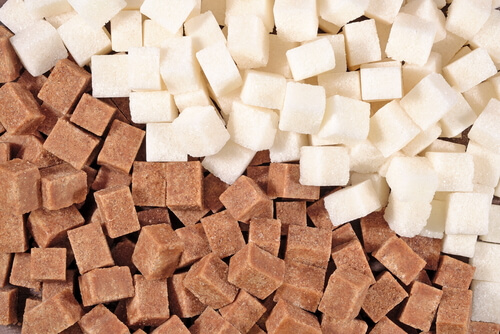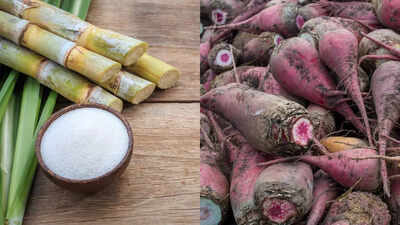The Great Debate: Sugar Beet Vs Sugar Cane - Which Is the Superior Option for Sugar?
The discussion over sugar beet versus sugar cane as the recommended sugar involves numerous crucial factors. Each offers distinct advantages and difficulties concerning production, flavor, and wellness implications. While sugar beet might interest those prioritizing sustainability, sugar cane has its very own cultural and cooking importance. As customers end up being much more conscious of their selections, the concern continues to be: which sweetener really sticks out in today's market?
The Origins of Sugar Beet and Sugar Cane
Although sugar cane has been cultivated for thousands of years, largely in exotic regions, sugar beet arised as a significant option in cooler environments during the 18th century. Sugar cane, native to Southeast Asia, was initial trained around 8000 BCE and spread out internationally with trade and expedition. Its high sucrose material made it an important plant, resulting in extensive ranches in regions like the Caribbean and Brazil.
On the other hand, sugar beet was very first cultivated in the Mediterranean around the 18th century, specifically gaining grip in Europe as an action to sugar cane scarcities. The plant flourishes in pleasant climates, making it appropriate for regions with chillier climate. The discovery that sugar could be drawn out from beet roots changed sugar manufacturing, specifically during the Napoleonic Battles when trade restrictions minimal cane sugar gain access to. The rise of sugar beet farming marked a turning point in the background of sweeteners, supplying a neighborhood resource for lots of countries.
Manufacturing Procedures: From Field to Sugar
The production processes of sugar beet and sugar cane reveal substantial differences in farming techniques, collecting methods, and refinement phases. Understanding these subtleties is crucial for valuing how each plant contributes to the overall sugar market. This comparison highlights the special attributes and difficulties connected with both resources of sweet taste.

Growing Techniques Contrast
Farming techniques for sugar beet and sugar cane expose distinct methods that influence their manufacturing procedures, from field preparation to last sweetener extraction. Sugar beet growing typically includes plowing and harrowing to produce a great seedbed, followed by seeding in rows to help with growth. This crop gain from cooler environments and is frequently planted in springtime. In contrast, sugar cane is typically planted in furrows with pre-sprouted cane items, needing a warm, tropical climate for perfect development. Cane fields are usually outlined to manage water effectively, given its requirement for significant irrigation. Both plants are handled with specific fertilization and parasite control techniques customized to their growth settings, impacting return quality and effectiveness in sweetener removal.

Gathering Techniques Described
Effective collecting methods for sugar beet and sugar cane play a crucial role in guaranteeing optimal return and quality of the end product. Sugar beet collecting usually utilizes mechanized origin harvesters, which efficiently uproot the beetroots from the dirt and different them from the vegetation. This method lessens damage to the beetroots and decreases labor prices. On the other hand, sugar cane harvesting may utilize either manual work or equipment, depending upon the area and range of manufacturing. Mechanical harvesters reduced the cane at the base and usually strip away the fallen leaves, enhancing the procedure for bigger areas. Both methods need cautious timing to assure the crops are harvested at peak sweet taste, affecting the quality of the final sugar item.
Refinement Process Distinctions
While both sugar beet and sugar cane go through strenuous improvement processes to change their raw types into useful sweeteners, the methods employed vary considerably. Sugar beet refinement begins with cleaning and slicing the beets into slim cossettes, followed by diffusion, where warm water essences sucrose. The resulting juice is after that detoxified, focused, and crystallized. In comparison, sugar cane handling includes squashing the stalks to draw out juice, which is after that cleared up making use of lime and warm to remove impurities. The cane juice is evaporated to create syrup prior to condensation. Eventually, while both processes aim to create white sugar, the distinct techniques highlight the distinct attributes of each source and their implications for flavor and purity in the final product.
Nutritional Profiles: What remains in Your Sweetener?
The nutritional profiles of sugar beet and sugar cane existing unique differences worth taking a look at. This contrast consists of aspects such as caloric content, mineral and vitamin existence, and variations in glycemic index. Understanding these variables can offer understandings right into just how each sweetener may affect general health and wellness.
Calorie Content Contrast
Comprehending the calorie material of sugar beet and sugar cane is essential for those conscious of their dietary selections. Both sugar largely include sucrose, adding a comparable caloric worth. Commonly, sugar beet includes about 387 calories per 100 grams, while sugar cane has about 390 calories per the same quantity. The small difference in caloric content may not significantly impact most diet plans; nevertheless, it is amazing for those carefully checking their calorie intake. Additionally, both sugar sources provide energy but do not have crucial nutrients, making them primarily resources of vacant calories. People looking for healthier options may want to take right into account these variables when choosing in between sugar beet and sugar cane as their chosen sugar.
Mineral and Vitamin Web Content
Calorie material provides just a part of the image when assessing sugar beet and sugar cane. Both resources of sugar differ noticeably in their mineral and vitamin accounts. Sugar beetroots are extremely abundant in crucial nutrients, consisting of potassium, magnesium, and iron. They also have useful link tiny quantities of vitamins such as B6 and folate, adding to their nutritional value. On the other hand, sugar cane uses a different set of benefits, containing calcium, phosphorus, and traces of B vitamins. While neither choice is a substantial source of minerals and vitamins contrasted to entire foods, sugar beets might have a minor side because of their greater mineral material. Inevitably, consumers looking for nutritional benefits from sweeteners ought to think about these differences in accounts.
Glycemic Index Distinctions
Glycemic index plays a crucial duty in reviewing just how different sugar impact blood glucose degrees. Sugar beet and sugar cane display significant differences in their glycemic responses. Generally, sugar beet has a reduced glycemic index contrasted to sugar cane, causing a slower and steadier surge in blood sugar levels after usage. This characteristic might make sugar beet a preferable choice for individuals taking care of diabetes or those looking for to maintain stable energy degrees. In comparison, sugar cane tends to create an extra rapid spike in blood sugar, which can cause quicker energy collisions. Recognizing these distinctions is significant for customers aiming to make informed dietary selections regarding sugar and their influence on overall wellness.
Environmental Influence: Sustainability Considerations
While both sugar beet and sugar cane are necessary resources of sugar, their environmental effects and sustainability considerations vary markedly. Sugar beetroots, largely grown in warm areas, generally need much less water and can be grown in varied environments. They likewise take advantage of plant turning methods, which boost dirt wellness and lower the requirement for synthetic fertilizers. Extensive farming of sugar beetroots can lead to dirt depletion and chemical use.
On the other hand, sugar cane thrives in exotic environments and commonly necessitates significant water sources for watering (Sugar beet vs sugar cane). The monoculture nature of sugar cane farming can intensify soil disintegration and biodiversity loss. In addition, the burning of cane check my site areas prior to harvest releases carbon emissions and adds to air pollution. Both plants encounter obstacles pertaining to environment adjustment, yet their varying cultivation methods profoundly affect their general sustainability accounts. Consequently, the option in between sugar beet and sugar cane includes considering these ecological impacts very carefully
Preference and Culinary Uses: Which Sugar Reigns Supreme?
The choice between sugar beet and sugar cane expands beyond ecological considerations to include taste and cooking applications. Sugar beet, often viewed as having a slightly different taste profile, tends to be less sweet than sugar cane. This refined difference can affect its use in dishes, specifically in baked items where a neutral sweetness is desired.
On the other hand, sugar cane is celebrated for its distinctive, abundant, and extra complicated flavor, making it a recommended choice for beverages and treats - Sugar beet vs sugar cane. Its natural molasses material can enhance the deepness of flavors in various recipes
In food preparation, sugar cane's flexibility shines via in marinades, lusters, and confections, while sugar beet is you can try this out commonly found in processed foods and sugar like granulated sugar. Eventually, the choice in between the 2 sweeteners frequently hinges on private taste choices and specific cooking applications, with each offering unique advantages in the kitchen area.
Health And Wellness Effects: Sugar Beet Vs Sugar Cane
Both sugar beet and sugar cane have distinctive health ramifications that can influence consumer selections. Sugar beet vs sugar cane. Sugar beet is typically concerned for its higher fiber material, which can aid gastrointestinal wellness. Additionally, it has specific anti-oxidants that might add to general wellness. On the other hand, sugar cane is abundant in nutrients such as calcium, potassium, and magnesium, using some mineral benefits
Both sources mostly consist of sucrose, which can lead to similar health and wellness issues when taken in exceedingly, such as weight problems, diabetes, and heart condition. The processing techniques additionally vary; sugar beet is usually improved more intensively, potentially resulting in a loss of particular nutrients. Customers worried about additives might prefer sugar cane, as it typically undertakes much less handling. Inevitably, comprehending these health and wellness implications can assist individuals towards making informed decisions regarding their sweetener options.
Consumer Preferences: Fads and Insights
Customer preferences for sugar have advanced substantially in the last few years, influenced by health trends, ecological concerns, and dietary selections. Raised recognition of the negative wellness impacts related to extreme sugar consumption has actually led numerous consumers to seek options. This shift has motivated an expanding interest in all-natural sweeteners, with sugar beet and sugar cane being at the leading edge of conversations.
Study shows that consumers are progressively favoring sugar beet due to its viewed environmental benefits, as it is usually grown closer to refining plants, minimizing transportation emissions. Conversely, sugar cane is frequently related to tropical regions and may bring assumptions of sustainability obstacles.

Regularly Asked Concerns
Exactly How Do Sugar Beet and Sugar Cane Affect Blood Glucose Levels?
Sugar beet and sugar cane both consist of sucrose, which can elevate blood glucose degrees. The influence mainly relies on private metabolic process and consumption amounts, but both resources add in a similar way to blood sugar responses in most cases.
Which Sugar Is Much Better for Baking and Food preparation?
When assessing sweeteners for baking and food preparation, one must think about structure, taste, and wetness retention. Sugar beet and sugar cane both supply distinct high qualities, with sugar cane often chosen for its richer taste profile in culinary applications.
Can Sugar Beet or Cane Be Utilized in Vegan Diets?
Both sugar beet and sugar cane can be utilized in vegan diet regimens. They are plant-derived sweeteners, making them suitable for individuals seeking vegan-friendly options without pet items, ensuring ethical selections in their cooking practices.
What Are the Historical Usages of Sugar Beet and Cane?
Historically, sugar beet and cane acted as vital resources of sweetness, with cane cultivated in tropical regions and beet in warm areas. Both have been indispensable to numerous societies, economic climates, and culinary customs throughout history.
Are There Any Alternatives to Sugar Beet and Cane?
Alternatives to sugar beet and cane include agave nectar, honey, maple syrup, and sweetening agents like aspartame and sucralose. These substitutes offer differing flavors and wellness advantages, appealing to diverse nutritional choices and restrictions.